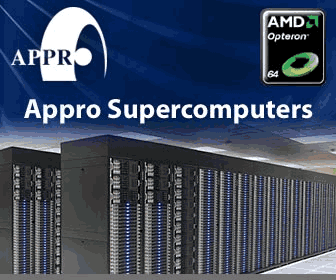BIG DATA
Appistry announces EAF 3.7 with new 'affinity' feature
Award-winning platform for extreme data and transaction processing removes barriers between computing and data: Appistry today announced Appistry Enterprise Application Fabric (EAF) 3.7, formerly codenamed "GMax." The new version introduces "Affinity," a feature allowing customers to more easily achieve extreme levels of scalability and performance for high-volume data and transaction processing. Affinity was influenced by the company's work building next-generation geospatial intelligence applications with customers such as GeoEye, whose fabric-based applications will help it process terabytes of satellite imagery each day.  Affinity enables faster, more powerful applications by allowing data to be partitioned and distributed to individual computers within an application fabric. Requests processed by the fabric-e.g. transactions, jobs, events or service invocations-are then dynamically routed to the machine containing the appropriate data. "One of the greatest barriers to scalability for traditionally architected applications is the need to constantly pull data from databases to process incoming work. It puts stress on the database and the network, and is often completely unnecessary," said Sam Charrington, Appistry vice president of product management and marketing. "By allowing data to reside on computers that can do the work, Appistry EAF allows customers to break through these barriers and field more scalable applications." Affinity allows developers and architects to easily deliver extremely scalable applications for high-volume data processing by allowing them to declaratively:
Affinity enables faster, more powerful applications by allowing data to be partitioned and distributed to individual computers within an application fabric. Requests processed by the fabric-e.g. transactions, jobs, events or service invocations-are then dynamically routed to the machine containing the appropriate data. "One of the greatest barriers to scalability for traditionally architected applications is the need to constantly pull data from databases to process incoming work. It puts stress on the database and the network, and is often completely unnecessary," said Sam Charrington, Appistry vice president of product management and marketing. "By allowing data to reside on computers that can do the work, Appistry EAF allows customers to break through these barriers and field more scalable applications." Affinity allows developers and architects to easily deliver extremely scalable applications for high-volume data processing by allowing them to declaratively:
 Affinity enables faster, more powerful applications by allowing data to be partitioned and distributed to individual computers within an application fabric. Requests processed by the fabric-e.g. transactions, jobs, events or service invocations-are then dynamically routed to the machine containing the appropriate data. "One of the greatest barriers to scalability for traditionally architected applications is the need to constantly pull data from databases to process incoming work. It puts stress on the database and the network, and is often completely unnecessary," said Sam Charrington, Appistry vice president of product management and marketing. "By allowing data to reside on computers that can do the work, Appistry EAF allows customers to break through these barriers and field more scalable applications." Affinity allows developers and architects to easily deliver extremely scalable applications for high-volume data processing by allowing them to declaratively:
Affinity enables faster, more powerful applications by allowing data to be partitioned and distributed to individual computers within an application fabric. Requests processed by the fabric-e.g. transactions, jobs, events or service invocations-are then dynamically routed to the machine containing the appropriate data. "One of the greatest barriers to scalability for traditionally architected applications is the need to constantly pull data from databases to process incoming work. It puts stress on the database and the network, and is often completely unnecessary," said Sam Charrington, Appistry vice president of product management and marketing. "By allowing data to reside on computers that can do the work, Appistry EAF allows customers to break through these barriers and field more scalable applications." Affinity allows developers and architects to easily deliver extremely scalable applications for high-volume data processing by allowing them to declaratively:
- Partition data and allow it to reside within an application fabric When developing applications to operate on large data sets, it is often advantageous to divide the data into manageable partitions, and locate it within the application fabric itself (as opposed in a traditional data tier). Static reference data may be moved into a fabric permanently, while dynamic data may be cached in the fabric for quicker access.
- Locate work on machines containing appropriate data Affinity allows work assigned to a fabric to be located on machines containing the data necessary for its processing. This eliminates the latency, bottlenecks and performance degradation associated with pulling large amounts of data from external databases or file systems.
- Locate work on machines with specific characteristics In addition to making decisions based on the availability of static or dynamic data, Affinity can also locate work based on machine characteristics-such as the amount of available RAM, or the presence of specialized hardware or software.
- Accumulate (and return to) local state information Affinity aids in the development of stateful applications, in which a series of transactions or requests operate on a single piece of locally held data. Using Affinity, subsequent requests are located on the computer containing the appropriate state information.
Other Features In addition to Affinity, Appistry EAF 3.7 introduces features allowing the easy migration of pre-existing high-performance computing (HPC) applications to a fabric, including those based on legacy standards such as MPI.
